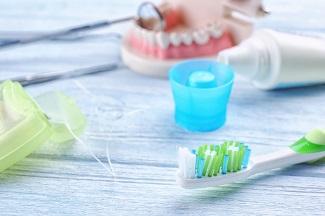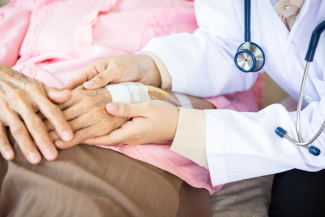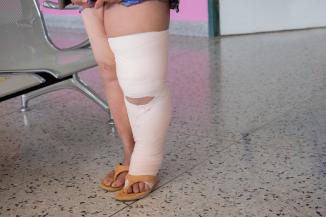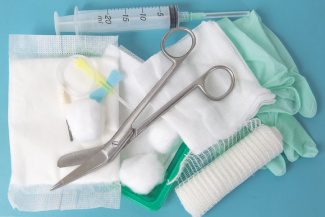Wound Care and Oral Care
December 5, 2019
Oral health is more than just important. As a child in a family supported by the state, we could afford hot water for a bath only once a week, but I cleaned my teeth twice a day and had regular dental visits. At school, we were taught to brush our teeth, and the twice a day routine was reinforced. I remember as a 16 year old showing my junior charges the scuzzy stuff at the gum margin and telling them it was called plaque. At nursing school, I once again was taught how to brush teeth, and we practiced on each other.
Oral hygiene may seem irrelevant to wound care, but there is no doubt that the mouth can release bacteria into the bloodstream and be the root cause of deep bone infections after orthopedic surgery, pneumonia in intensive care unit (ICU), and subacute bacterial endocarditis.1 It was not long ago I heard a conversation about biofilm, and one person stated, "You can't see it." Yes, you can. It is the plaque on your teeth and the slime on the catheter you remove. If you want to see it in action, go to YouTube. It is more than amazing that there are hordes of bacteria waving in unison, amoebas trying to push through the crowds. You will start brushing up on your brushing, I promise! I first saw this short video at the New England regional conference last month and started thinking about oral care.
The Importance of Oral Hygiene
Being a child born at the end of the Baby Boomer era, I may have been rather candy dependent like my peers, but I was from a poor family, and candies were not a part of my diet. However, sugar sandwiches were not unheard of, and my mother had been a pastry cook, so I definitely got my fair share of C6H22O11. Both my parents had their own teeth, which at the time was a little unusual in the United Kingdom. At the beginning of the National Health Service, dentistry had been free, and many people went straight to the dentist to have all their teeth removed and get dentures. This was true of my aunts and several of my mother's friends. Although my father had most of his own teeth, he blamed the dental problems he did have on poor mouth care while in the hospital.
During the Cypriot War in 1956, my father slipped off the ladder to the bridge on the HMS Birmingham (sister ship to the Belfast, which is now a naval museum on the Thames in London). He broke his neck and suffered a complete spinal injury that left him a tetraplegic. It was decided that it was an act of God, so there was no compensation, just a miniscule monthly payment that my mother managed well enough to keep our family together. He suffered a traumatic amputation of his right great toe when being turned in a Stryker frame and several urinary tract infections (UTIs) that led him to lose a kidney.
The loss of two teeth and the need for numerous fillings because of the lack of good mouth care were, at the time, of much less consequence. I remember my mother recounting that the nurses would poke sponge sticks into his mouth. Eventually, with his head out of traction, he learned to use his left hand and was able to clean his own teeth with no more problems. My mother got him out of the hospital, by eventually convincing the staff that he would do better in his own home, which was true—no more UTIs and no pneumonia (despite his smoking habit!). Of course, nowadays such a spinal injury would have him out of the ICU within a week and off to rehab to get that good left hand going before the plaque buildup could cause a problem! But back in 1956-1958, Ludwig Guttmann had been running the spinal injury unit at Stoke-Mandeville Hospital for a decade, and antibiotics, modern surgery, and skeletal traction were saving the lives of people who, until that time, were not able to be treated. Before such units, spinal injury patients succumbed to bladder and chest infection within a few months and then pressure sores and kidney disease if survival allowed; it was a big turnaround.
Oral Hygiene and Nursing
At nursing school in 1973, our mouth care trays were made up of a gallipot, a pair of forceps, and 2×2 woven gauze; we had a tutor, however, who was convinced that the trays were a waste of money and insisted we use the patient's toothbrush. While practicing on each other, we discovered using toothpaste was a bad idea because it becomes frothy and nauseating. Each morning, patients requiring mouth care were meant to have a fresh tray, mouthwash was put in the gallipot, and their teeth cleaned with their toothbrush. In reality, the trays were changed, and gauze was dipped into mouthwash and clasped with the forceps and run around the gum margins.
I don't think I saw a toothbrush being used again until I became an ICU nurse. There we would use tiny toothbrushes and do mouth care on the left of the mouth when we turned the patient right and the other side at the next turn. We held a Yankauer suction tool in one hand and used mouthwash brushing from the base of the gum then over the tooth; we avoided the endotracheal (ET) tube and repositioned it. I wonder whether some of the modern ET tube holders allow for easy enough oral access. Mouth care, like foot care, is rather the Cinderella of nursing. I would like to say "we must be careful not to give it over to our assistants," but sadly, it is too late. Ultrasonic toothbrushes have changed personal oral care and made a difference to maintenance of oral hygiene. It would be a fine project for a stepdown unit to compare modern mouth care strategies with the use of an ultrasonic brush.
Reference
1. Chen L, Wen Y. The role of bacterial biofilm in persistent infections and control strategies. Int J Oral Sci. 2011;3:66-73.
About the Author
Margaret Heale has a clinical consulting service, Heale Wound Care in Southeastern Vermont and draws on her extensive experience as a wound, ostomy and continence nurse in acute and long-term care settings to provide education and holistic care in her practice.
The views and opinions expressed in this blog are solely those of the author, and do not represent the views of WoundSource, HMP Global, its affiliates, or subsidiary companies.













Follow WoundSource
Tweets by WoundSource